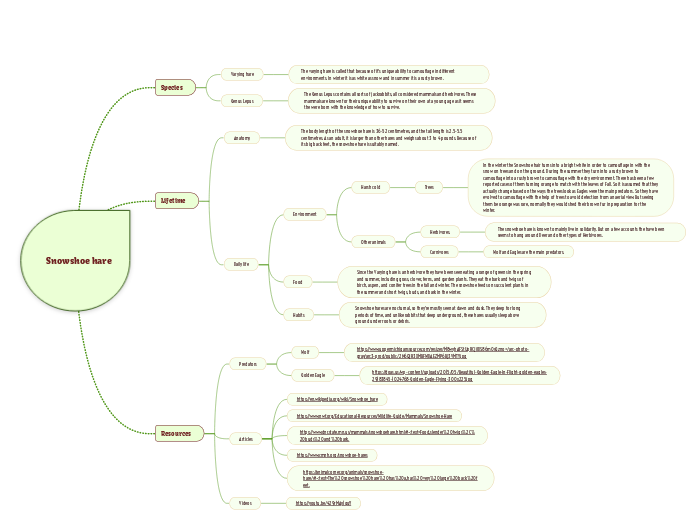Snowshoe hare
Resources
Videos
https://youtu.be/429rMAy1quY
Articles
https://animalcorner.org/animals/snowshoe-hare/#:~:text=The%20snowshoe%20hare%20has%20a,has%20very%20large%20back%20feet.
https://www.cmnh.org/snowshoe-hares
https://www.dnr.state.mn.us/mammals/snowshoehare.html#:~:text=Food,slender%20twigs%2C%20buds%20and%20bark.
https://www.nwf.org/Educational-Resources/Wildlife-Guide/Mammals/Snowshoe-Hare
https://en.wikipedia.org/wiki/Snowshoe_hare
Predators
Golden Eagle
https://doas.us/wp-content/uploads/2015/05/Beautiful-Golden-Eagle-In-Flight-golden-eagles-29183845-1024-768-Golden-Eagle-Flying-300x225.jpg
Wolf
https://www.uppermichiganssource.com/resizer/M8wyhAFStUpRCJiIDS86m0sGzno=/arc-photo-gray/arc3-prod/public/2N6QJR3XMBFWDAEZMP6BJ3VMTY.jpg
Lifetime
Daily life
Habits
Snowshoe hares are nocturnal, so they're mostly seen at dawn and dusk. They sleep for long periods of time, and unlike rabbits that sleep underground, these hares usually sleep above ground under roots or debris.
Food
Since the Varying hare is an herbivore they have been seen eating a range of greens in the spring and summer, including grass, clover, ferns, and garden plants. They eat the bark and twigs of birch, aspen, and conifer trees in the fall and winter. The snowshoe feeds on succulent plants in the summer and short twigs, buds, and bark in the winter.
Environment
Other animals
Carnivores
Wolf and Eagles are the main predators.
Herbivores.
The snowshoe hare is known to mainly live in solidarity. But on a few accounts the have been seems to hang around Deer and other types of Herbivores.
Harsh cold
Trees
In the winter the Snowshoe hair turns into a bright white in order to camouflage in with the snow on trees and on the ground. During the summer they turn into a rusty brown to camouflage into a rusty brown to camouflage with the dry environment. There has been a few reported cases of them turning orange to match with the leaves of Fall. So it is assumed that they actually change based on the ways the trees look as Eagles were the main predators. So they have evolved to camouflage with the help of trees to avoid detection from an aerial view. But seeing them be orange was rare, normally they would shed their brown fur in preparation for the winter.
Anatomy
The body length of the snowshoe hare is 36-52 centimetres, and the tail length is 2.5-5.5 centimetres. As an adult, it is larger than other hares and weighs about 3 to 4 pounds. Because of its big back feet, the snowshoe hare is suitably named.
Species
Genus Lepus
The Genus Lepus contains all sorts of jackrabbits, all considered mammals and herbivores. These mammals are known for their unique ability to survive on their own at a young age as it seems the were born with the knowledge of how to survive.
Varying hare
The varying hare is called that because of it's unique ability to camouflage in different environments. In winter it is as white as snow and in summer it is a rusty brown.









